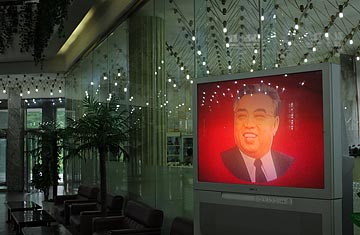
A picture of the late North Korean leader Kim Il Sung is displayed on a television in Pyongyang
In 2007 and 2008, photojournalist Tomas Van Houtryve visited North Korea by infiltrating a communist solidarity delegation. In the first of a three-part TIME.com series, he reports on the elaborate ruse that is required to enter the world's most isolated country.
One of the more pleasant surprises about Pyongyang is that the North Korean capital — surely the most isolated capital city on earth — has a handful of bookshops for foreigners. Less surprisingly, most of the books have been written by either Kim Il Sung, the Great Leader and founder of North Korea, or his son the Dear Leader, Kim Jong Il. Most are stern instruction manuals on how to be a better communist. There are also a number of guides and glossy souvenir books, more than enough for a place than receives less foreign visitors in a year than the Louvre does in an hour.
But it is in the personal testimonies that the propagandists really hit their stride. In the preface of a 220-page paperback titled A Young Man's Memoirs on His Escape from South Korea, the author writes, "I deserted the south, which is regarded as a burial ground for human beings, and went to the blissful land of the north." For good measure, he adds, "South Korea is a living hell unfit for human habitation."
I've visited the Democratic People's Republic of Korea (DPRK) twice, in 2007 and 2008, and each time I had to do some elaborate fabricating of my own. Like Euna Lee and Laura Ling, I am an American and a journalist, a combination that makes reporting about North Korea perilous. I knew that getting a visa was out of the question if I identified myself truthfully. Even if I did somehow manage to wangle one, tourists in North Korea are strictly policed. They are not allowed to leave their hotels without the permission and presence of government guides. They have their mobile phones, passports and return air tickets confiscated on the day of arrival. All itineraries are dictated in advance.
To get more than a tour of the dictator's diorama — to develop even a hint of knowledge about real life in North Korea — I had to play the system. At the height of the Cold War, solidarity delegations allowed loyal party members to visit sister countries within the communist bloc. The trusted cadres were given special access to visit model schools, hospitals and farms. A few far-left organizations have kept this tradition alive today by organizing friendship brigades to Cuba and North Korea. By fabricating my identity — I grew a mustache, changed my hair and clothes, adopted a foreign accent and got a second passport from a small, inoffensive European country — one of these groups let me in. I got my visa.
On the ancient Soviet Koryo Airways Ilyushin, departing from Beijing, I was handed the English-language Pyongyang Times. That day's front page showed a photo of a smiling Kim Jong Il under the headline "DPRK Shines Under the Leadership of Brilliant Commander." The "glorious" and "superb" Dear Leader was mentioned in nearly every article inside, giving "on-the-spot guidance" to industrial workers, farms or his generals.
The rest of the flight was uneventful, and within two hours we touched down on a runway surrounded by guard posts and barbed wire. The tarmac was empty. From the roof of the terminal building, a huge portrait of Kim Il Sung smiled down. After passing the entrance formalities, we were loaded onto a bus with four state guides. The photographer in me was ecstatic at what I was seeing. The visual texture of North Korea is different from any country on earth. It is stark and bizarre to the point of being surreal. Pyongyang may have more monuments and wide avenues than Washington or Paris — all built in the past 50 years to the specs of the Kims' jarring taste — yet cars and pedestrians are nearly absent. It's like an empty movie set.
By the time our bus arrived at a gargantuan bronze statue of the Great Leader, where we were instructed to bow, I had already begun to slip dangerously out of character. I was shooting different angles, moving my lens like a pro. The minders and other delegation members said nothing. But I should have known that I was compromising my cover.
Read part 2 and part 3 of Tomas Van Houtryve's "Journey to North Korea."
